Highlights
- Pixel 8 Pro features Google’s latest Tensor G3 SoC for enhanced performance.
- Significant upgrades in camera technology, including a new 48MP ultra-wide lens.
- Improved display with higher peak brightness and adaptive refresh rate.
- Pixel 8 Pro boasts a slightly larger 5050mAh battery for extended usage.
As Google introduces its latest flagship smartphone, the Pixel 8 Pro, consumers and tech enthusiasts alike are keen to understand how it differentiates from its predecessor, the Pixel 7 Pro.
This comprehensive analysis aims to shed light on the nuances between the two devices, delving into specifications, pricing, and other relevant aspects.
Pricing and Availability
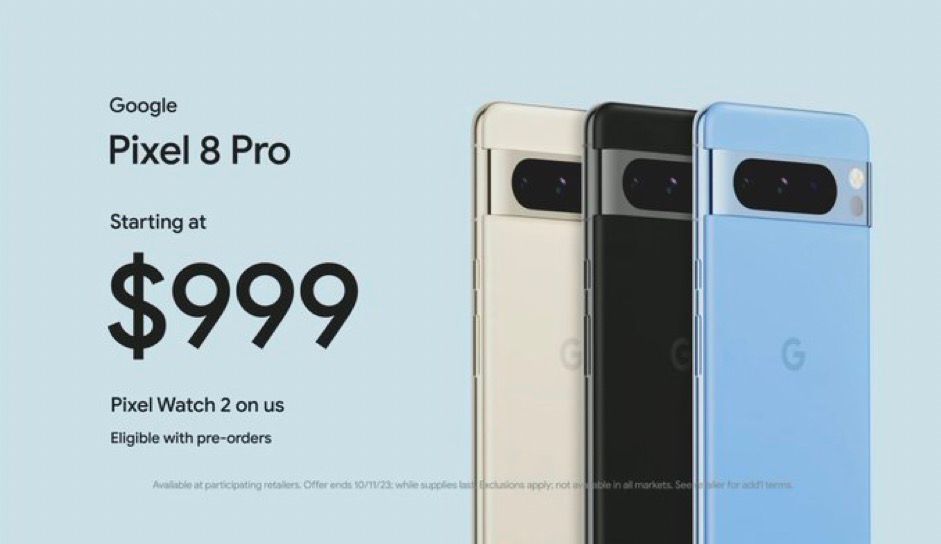
Pixel 8 Pro
- Priced at Rs. 1,06,999 for the 128GB model.
- Available in Bay, Obsidian, and Porcelain colour options.
- Sold exclusively on Flipkart, with pre-orders starting on October 4.
Pixel 7 Pro
- Original pricing may now vary as it’s an older model.
- Currently selling at Rs 65,999 on Flipkart
- Initially launched in Snow, Obsidian, and Hazel colors.
Performance
Pixel 8 Pro
- Powered by Google’s in-house Tensor G3 SoC
- 12GB of LPDDR5 RAM
- 256GB UFS 3.1 Storage
Pixel 7 Pro
- Uses the previous-generation Tensor G2 SoC
- 12GB LPDDR5 RAM
- 128GB UFS 3.1 storage
Under the hood, the Pixel 8 Pro is powered by Google’s latest Tensor G3 SoC, promising improved speeds and better optimization for AI-based tasks compared to the Tensor G2 found in the Pixel 7 Pro.
While both phones offer 12GB of RAM, the newer model is expected to deliver a more responsive and fluid experience, particularly in demanding applications.
Display Specifications
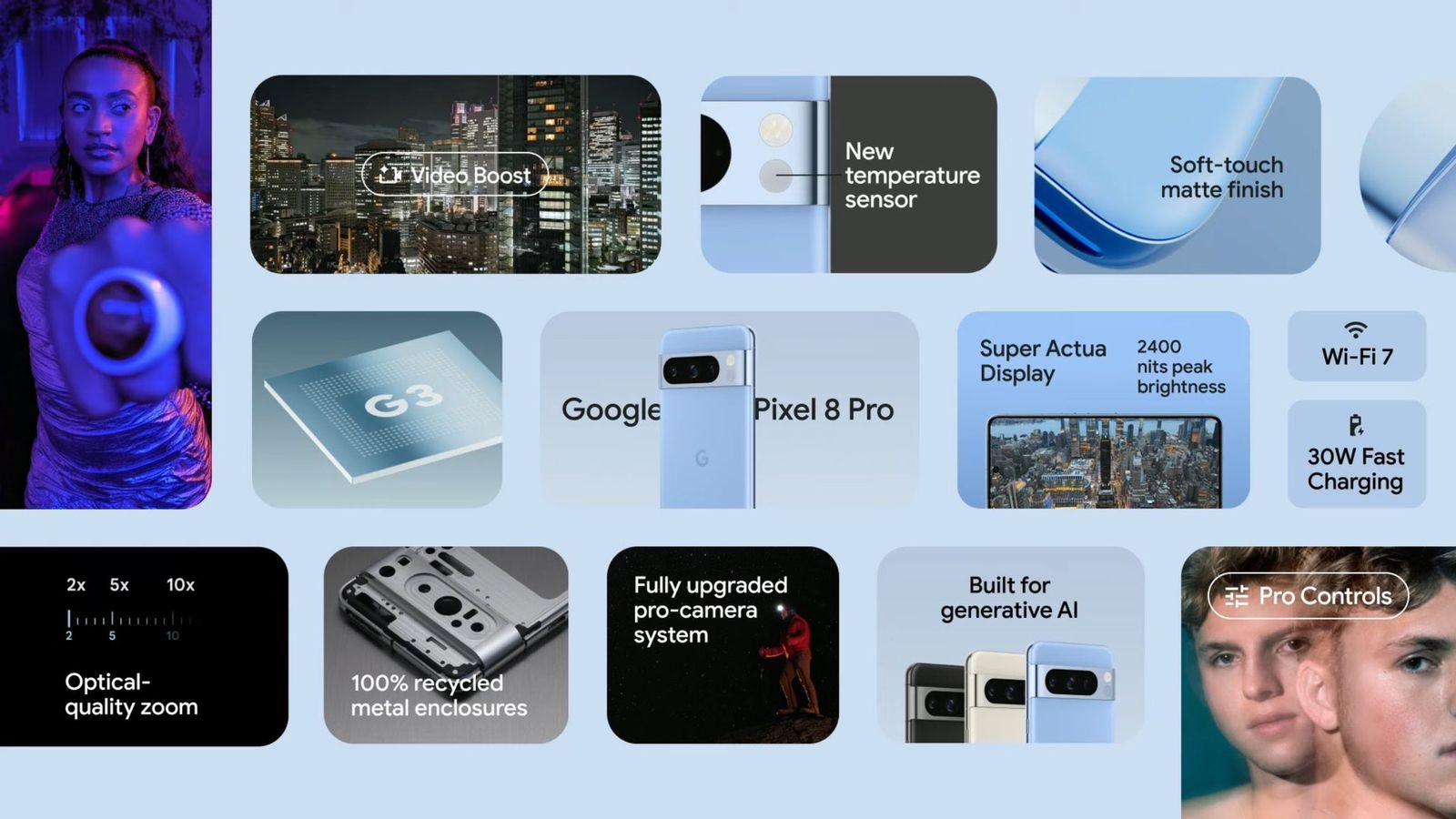
Pixel 8 Pro
- Boasts a 6.7-inch Super Actua OLED display.
- A resolution of 2992 x 1344 pixels and 489 ppi.
- Adaptive refresh rate ranging from 1Hz to 120Hz.
- Peak brightness goes up to an impressive 2400 nits.
Pixel 7 Pro
- Features a 6.7-inch LTPO display.
- A resolution of 3120 x 1440 pixels and 512 ppi.
- Limited adaptive refresh rate that switches between 60Hz and 120Hz.
- Peak brightness tops at 1500 nits.
The Pixel 8 Pro comes equipped with a 6.7-inch Super Actua OLED display featuring an adaptive refresh rate that ranges from 1-120Hz, offering smoother visuals and enhanced energy efficiency.
The screen’s peak brightness of 2400 nits is a significant improvement over the Pixel 7 Pro’s 1500 nits, providing better visibility in diverse lighting conditions.
While the Pixel 8 Pro has a slightly lower pixel density of 489 ppi compared to its predecessor’s 512 ppi, the difference is negligible for the average user.
Overall, the Pixel 8 Pro’s display technology presents a compelling upgrade in terms of versatility and visual performance.
Battery and Charging
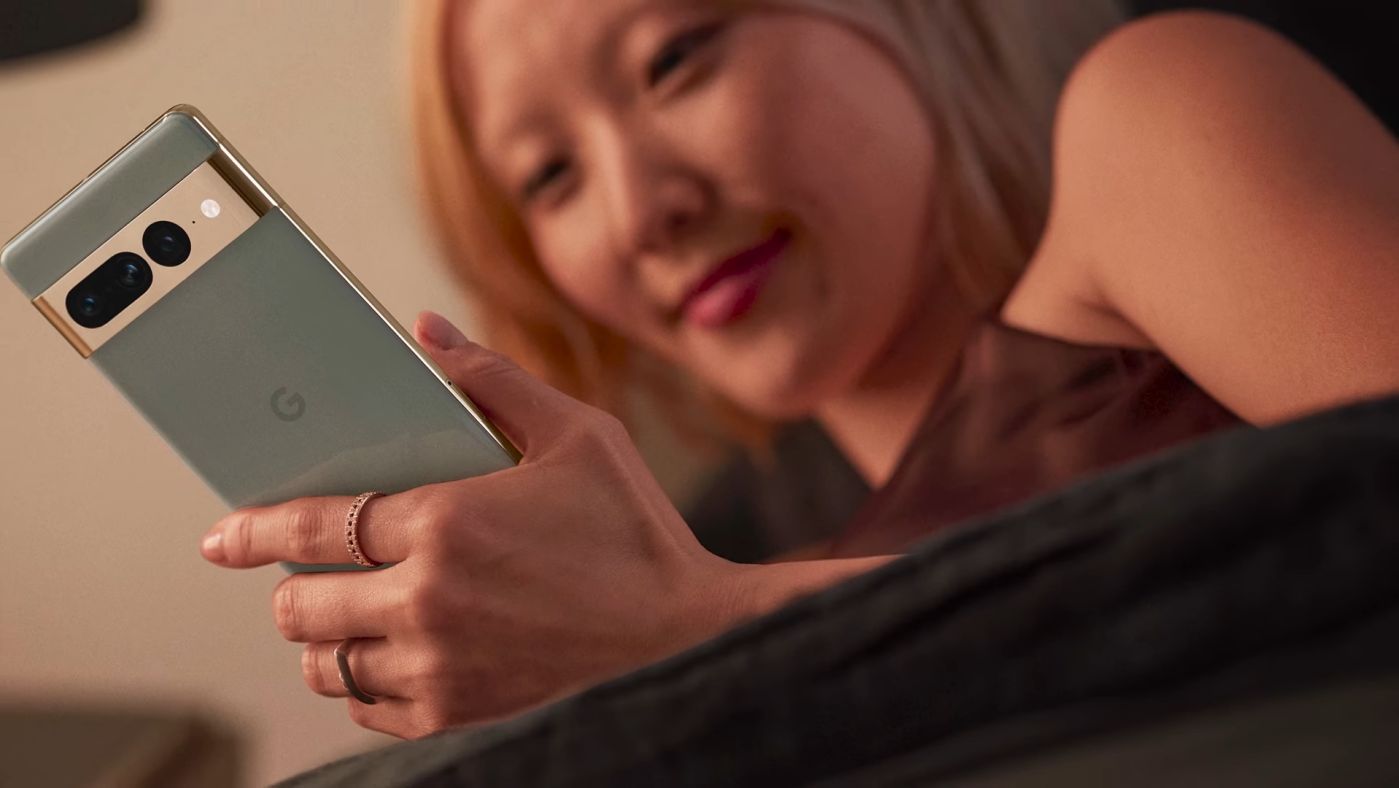
Pixel 8 Pro
- Houses a 5050mAh battery.
- Supports 30W fast charging and 12-18W wireless charging.
Pixel 7 Pro
- Comes with a 4500mAh battery.
- Also supports fast and wireless charging, but the wireless charging rate is unspecified.
Both the Pixel 8 Pro and Pixel 7 Pro boast impressive battery longevity, claiming up to 24 hours of regular use and an extended 72 hours when employing the Extreme Battery Saver mode.
However, the Pixel 8 Pro takes it a step further with a slightly beefed-up 5050mAh battery, compared to the 4500mAh unit in its predecessor.
While the difference in capacity may not translate into dramatically extended use, it does provide a marginal edge that could prove beneficial in more demanding scenarios, such as high-performance gaming or extended video streaming.
Camera Configuration
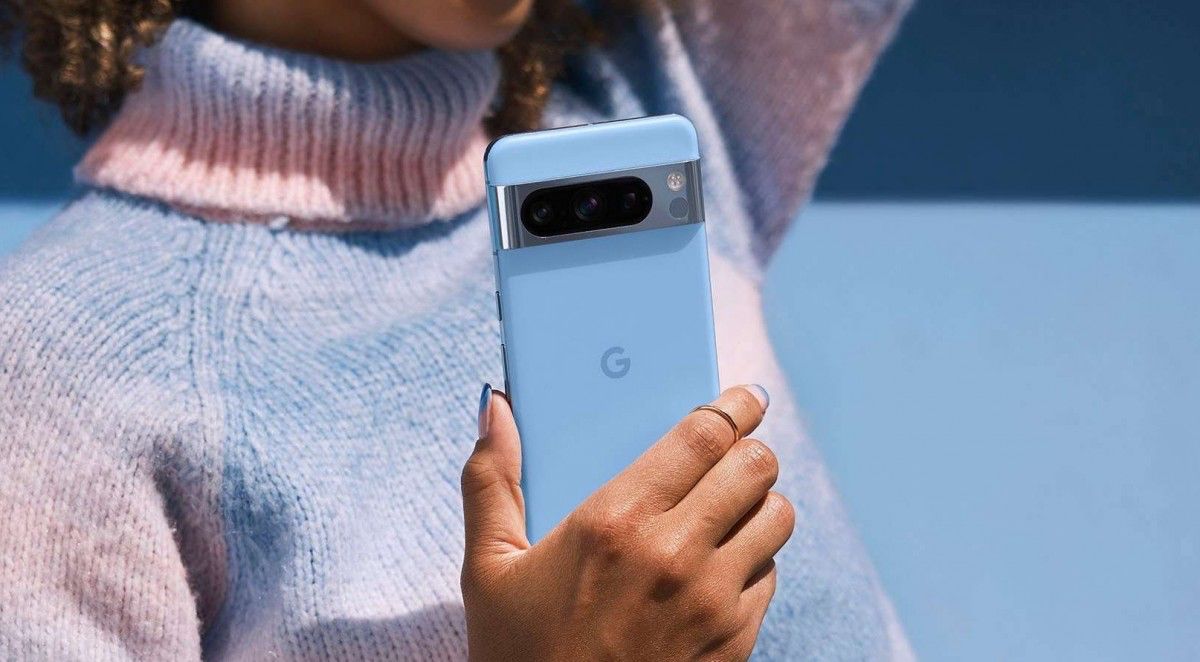
Pixel 8 Pro
- 50MP main camera with f/1.68 aperture and 1.2μm pixel pitch.
- A brand new 48MP ultra-wide camera with f/1.95 aperture and 0.8μm pixel pitch.
- 48MP telephoto lens with f/2.8 aperture and 0.7μm pixel pitch.
- Autofocus on the selfie camera.
Pixel 7 Pro
- 50MP main camera but with an f/1.85 aperture.
- 12MP ultra-wide camera with f/2.2 aperture and 1.25μm pixel pitch.
- 48MP telephoto lens but with an f/3.5 aperture.
The Pixel 8 Pro takes significant strides in camera technology, setting itself apart particularly in the ultra-wide and low-light departments.
The new ultra-wide lens sports a 48MP sensor with an f/1.95 aperture, a considerable upgrade from the Pixel 7 Pro’s 12MP sensor and f/2.2 aperture.
This translates to higher-resolution images and better low-light performance. Similarly, the main and telephoto lenses also feature more light-sensitive apertures.
Additional Features
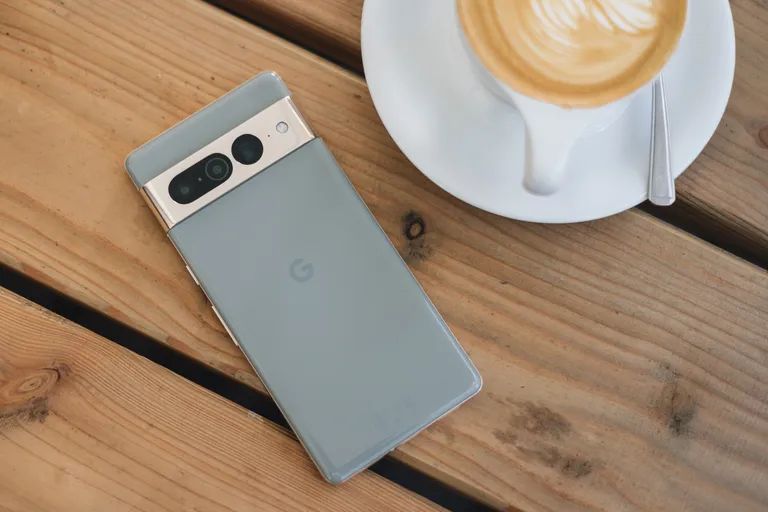
Pixel 8 Pro
- Comes with a temperature sensor.
- Offers WiFi 7 connectivity.
Pixel 7 Pro
- Does not include a temperature sensor.
- Supports WiFi 6E.
The Pixel 8 Pro includes a unique temperature sensor and offers more advanced WiFi 7 connectivity, representing incremental but potentially useful enhancements.
Conclusion
The Pixel 8 Pro builds upon its predecessor by offering a more dynamic display, a slightly improved battery, enhanced camera specifications, and a faster SoC.
While the Pixel 7 Pro is still a capable device, those looking for the latest features and technologies may find the Pixel 8 Pro to be a compelling upgrade.
Comparison Table
Google Pixel 8 Pro vs Google Pixel 7 Pro
| Google Pixel 8 Pro | Google Pixel 7 Pro | |
|---|---|---|
| Display size, tech, resolution, refresh rate, brightness | 6.7-inch OLED; 3,120×1,440 pixels; 1-120Hz adaptive refresh rate | 6.7-inch OLED; 3,120×1,440 pixels; 120Hz adaptive refresh rate |
| Pixel density | 489 ppi | 512 ppi |
| Dimensions (inches) | 6.4 x 3.0 x 0.3 in | 6.4 x 3.0 x 0.3 in |
| Dimensions (millimeters) | 162.6 x 76.5 x 8.8 mm | 162.9 x 76.6 x 8.9 mm |
| Weight (grams, ounces) | 213 g (7.5 oz) | 212 g (7.5 oz) |
| Mobile software | Android 14 | Android 13 |
| Camera | 50-megapixel (wide), 48-megapixel (ultrawide), 48-megapixel (telephoto) | 50-megapixel (wide), 12-megapixel (ultrawide), 48-megapixel (telephoto) |
| Front-facing camera | 10.5-megapixel | 10.8-megapixel |
| Video capture | 4K | 4K |
| Processor | Google Tensor G3 | Google Tensor G2 |
| RAM/storage | 12GB RAM + 128GB, 256GB, 512GB, 1TB | 12GB RAM + 128GB, 256GB, 512GB |
| Expandable storage | None | |
| Battery | 5,050 mAh | 5,000 mAh |
| Fingerprint sensor | Under display | Under display |
| Connector | USB-C | USB-C |
| Headphone jack | None | None |
| Special features | 5G (Sub 6 and mmWave); VPN by Google One; 7 years of OS, security and Feature Drop updates; front-facing camera has autofocus; 13W Qi wireless charging; 30W wired charging; USB-3.2 speeds via USB-C; IP68 dust and water resistance; Gorilla Glass Victus 2 on front and back | 5G, Magic Eraser, Photo Unblur, Real Tone, Face Unblur, Long Exposure Mode, Action Pan; Hold For Me, Wait Times, Direct My Call, Live Translate |
| US price off-contract | $999 (128GB) | $899 (128GB) |
| UK price | £999 (128GB) | £849 (128GB) |
| Australia price | AU$1,699 (128GB) | AU$1,299 (128GB) |
GOOGLE PIXEL 8 PRO KEY SPECIFICATIONS
Key Specs
| RAM | 12 GB |
| Processor | Google Tensor G2 |
| Rear Camera | 64 MP + 48 MP + 12 MP |
| Front Camera | 16 MP |
| Battery | 5100 mAh |
| Display | 6.52 inches (16.56 cm) |
General
| Launch Date | May 10, 2023 (Unofficial) |
| Operating System | Android v12 |
Performance
| Chipset | Google Tensor G2 |
| CPU | Octa core (2.85 GHz, Dual core, Cortex X1 + 2.35 GHz, Dual core, Cortex A78 + 1.8 GHz, Quad core, Cortex A55) |
| Architecture | 64 bit |
| Fabrication | 4 nm |
| Graphics | Mali-G710 MC10 |
| RAM | 12 GB |
Display
| Display Type | Super AMOLED |
| Screen Size | 6.52 inches (16.56 cm) |
| Resolution | 1440 x 3120 pixels |
| Pixel Density | 527 ppi |
| Screen to Body Ratio (calculated) | 83.71 % |
| Bezel-less display | Yes |
| Touch Screen | Yes, Capacitive Touchscreen, Multi-touch |
| Refresh Rate | 144 Hz |
Design
| Height | 162.6 mm Compare Size |
| Width | 76.5 mm |
| Thickness | 8.7 mm |
Camera
| MAIN CAMERA | ||
| Camera Setup | Triple | |
| Resolution | 64 MP f/1.9, Wide Angle, Primary Camera 48 MP f/3.5, Telephoto Camera 12 MP f/2.2, Ultra-Wide Angle Camera |
|
| Autofocus | Yes | |
| Flash | Yes, Dual LED Flash | |
| Image Resolution | 9000 x 7000 Pixels | |
| Settings | Exposure compensation, ISO control | |
| Shooting Modes | Continuous Shooting High Dynamic Range mode (HDR) |
|
| Camera Features | Digital Zoom Auto Flash Face detection Touch to focus |
|
| Video Recording | 1920×1080 @ 30 fps | |
| FRONT CAMERA | ||
| Camera Setup | Single | |
| Resolution | 16 MP f/2.2, Ultra-Wide Angle, Primary Camera | |
| Video Recording | 1920×1080 @ 30 fps | |
Battery
| Capacity | 5100 mAh |
| Type | Li-Polymer |
| Removable | No |
| Quick Charging | Yes, Fast |
| USB Type-C | Yes |
Storage
| Internal Memory | 256 GB |
| Expandable Memory | No |
Network & Connectivity
| SIM Slot(s) | Dual SIM, GSM+GSM |
| SIM Size | SIM1: Nano, SIM2: eSIM |
| Network Support | 5G Not Supported in India, 4G Supported in India, 3G, 2G |
| VoLTE | Yes |
| SIM 1 |
4G Bands:
TD-LTE 2300(band 40)
FD-LTE 1800(band 3) 3G Bands:
UMTS 1900 / 2100 / 850 / 900 MHz
2G Bands:
GSM 1800 / 1900 / 850 / 900 MHz
GPRS:
Available
EDGE:
Available
|
| SIM 2 |
4G Bands:
TD-LTE 2300(band 40)
FD-LTE 1800(band 3) 3G Bands:
UMTS 1900 / 2100 / 850 / 900 MHz
2G Bands:
GSM 1800 / 1900 / 850 / 900 MHz
GPRS:
Available
EDGE:
Available
|
| Wi-Fi | Yes, Wi-Fi 4 (802.11 b/g/n) |
| Wi-Fi Features | Mobile Hotspot |
| Bluetooth | Yes, v5.2 |
| GPS | Yes with A-GPS, Glonass |
| USB Connectivity | Mass storage device, USB charging |
Multimedia
| Loudspeaker | Yes |
| Audio Jack | USB Type-C |
Sensors
| Fingerprint Sensor | Yes |
| Fingerprint Sensor Position | On-screen |
| Other Sensors | Light sensor, Proximity sensor, Accelerometer, Compass, Gyroscope |
GOOGLE PIXEL 7 PRO 5G KEY SPECIFICATIONS
Key Specs
| RAM | 12 GB |
| Processor | Google Tensor G2 |
| Rear Camera | 50 MP + 12 MP + 48 MP |
| Front Camera | 10.8 MP |
| Battery | 5000 mAh |
| Display | 6.7 inches (17.02 cm) |
General
| Launch Date | October 6, 2022 (Official) |
| Operating System | Android v13 |
Performance
| Chipset | Google Tensor G2 |
| CPU | Octa core (2.85 GHz, Dual core, Cortex X1 + 2.35 GHz, Dual core, Cortex A78 + 1.8 GHz, Quad core, Cortex A55) |
| Architecture | 64 bit |
| Fabrication | 4 nm |
| Graphics | Mali-G710 MC10 |
| RAM | 12 GB
Best in Class
|
| RAM Type | LPDDR5 |
Display
| Display Type | OLED |
| Screen Size | 6.7 inches (17.02 cm) |
| Resolution | 1440 x 3120 pixels |
| Aspect Ratio | 19.5:9 |
| Pixel Density | 513 ppi
Best in Class
|
| Screen to Body Ratio (calculated) | 88.12 % |
| Screen Protection | Corning Gorilla Glass, Glass Victus |
| Bezel-less display | Yes with punch-hole display |
| Touch Screen | Yes, Capacitive Touchscreen, Multi-touch |
| Brightness | 1500 nits |
| HDR 10 / HDR+ support | Yes, HDR 10+ |
| Refresh Rate | 120 Hz |
Design
| Height | 162.9 mm Compare Size |
| Width | 76.6 mm |
| Thickness | 8.9 mm
Good
|
| Weight | 212 grams
Poor
|
| Build Material | Back: Gorilla Glass |
| Colours | Obsidian, Snow, Hazel |
| Waterproof | Yes, Water resistant (up to 30 minutes in a depth of 1.5 meter), IP68 |
| Ruggedness | Dust proof |
Camera
| MAIN CAMERA | ||
| Camera Setup | Triple | |
| Resolution | 50 MP f/1.85, Wide Angle (82° field-of-view), Primary Camera(25 mm focal length, 1.31″ sensor size, 1.2µm pixel size)12 MP f/2.2, Ultra-Wide Angle Camera(2.9″ sensor size, 1.25µm pixel size)48 MP f/3.5, Telephoto Camera(120 mm focal length, 2.55″ sensor size, 0.7µm pixel size) | |
| Autofocus | Yes, Laser autofocus | |
| OIS | Yes | |
| Flash | Yes, Dual LED Flash | |
| Image Resolution | 8150 x 6150 Pixels | |
| Settings | Exposure compensation, ISO control | |
| Shooting Modes | Continuous Shooting High Dynamic Range mode (HDR) |
|
| Camera Features | Digital Zoom Auto Flash Face detection Touch to focus |
|
| Video Recording | 3840×2160 @ 30 fps 1920×1080 @ 30 fps |
|
| FRONT CAMERA | ||
| Camera Setup | Single | |
| Resolution | 10.8 MP f/2.2, Ultra-Wide Angle, Primary Camera(21 mm focal length, 3.1″ sensor size, 1.22µm pixel size) | |
| Camera Features | Fixed Focus | |
| Video Recording | 3840×2160 @ 30 fps 1920×1080 @ 30 fps |
|
Battery
| Capacity | 5000 mAh |
| Type | Li-Polymer |
| Removable | No |
| Wireless Charging | Yes |
| Quick Charging | Yes, Fast, 30W: 50 % in 30 minutes |
| USB Type-C | Yes |
Storage
| Internal Memory | 128 GB
Best in Class
|
| Expandable Memory | No |
| User Available Storage | Up to 109 GB |
| USB OTG | Yes |
| Storage Type | UFS 3.1 |
Network & Connectivity
| SIM Slot(s) | Dual SIM, GSM+GSM |
| SIM Size | SIM1: Nano, SIM2: eSIM |
| Network Support | 5G Supported in India, 4G Supported in India, 3G, 2G |
| VoLTE | Yes |
| SIM 1 |
5G Bands:
FDD N1 / N2 / N3 / N5 / N7 / N8 / N20 / N25 / N28 / N30
TDD N38 / N40 / N41 / N48 / N66 / N71 / N77 / N78 4G Bands:
TD-LTE 2600(band 38) / 2300(band 40) / 2500(band 41) / 1900(band 39)
FD-LTE 2100(band 1) / 1800(band 3) / 2600(band 7) / 900(band 8) / 700(band 28) / 1900(band 2) / 1700(band 4) / 850(band 5) / 700(band 13) / 700(band 14) / 700(band 17) / 850(band 18) / 850(band 19) / 800(band 20) / 1900(band 25) / 850(band 26) / 700(band 29) / 2300(band 30) 3G Bands:
UMTS 1900 / 2100 / 850 / 900 MHz
2G Bands:
GSM 1800 / 1900 / 850 / 900 MHz
GPRS:
Available
EDGE:
Available
|
| SIM 2 |
4G Bands:
TD-LTE 2600(band 38) / 2300(band 40) / 2500(band 41) / 1900(band 39)
FD-LTE 2100(band 1) / 1800(band 3) / 2600(band 7) / 900(band 8) / 700(band 28) / 1900(band 2) / 1700(band 4) / 850(band 5) / 700(band 13) / 700(band 14) / 700(band 17) / 850(band 18) / 850(band 19) / 800(band 20) / 1900(band 25) / 850(band 26) / 700(band 29) / 2300(band 30) 3G Bands:
UMTS 1900 / 2100 / 850 / 900 MHz
2G Bands:
GSM 1800 / 1900 / 850 / 900 MHz
GPRS:
Available
EDGE:
Available
|
| SAR Value | Head: 1.09 W/kg, Body: 0.91 W/kg |
| Wi-Fi | Yes, Wi-Fi 6 (802.11 a/b/g/n/ac/ax) 5GHz, MIMO |
| Wi-Fi Features | Wi-Fi Direct, Mobile Hotspot |
| Bluetooth | Yes, v5.2 |
| GPS | Yes with A-GPS, Glonass |
| NFC | Yes |
| USB Connectivity | Mass storage device, USB charging |
Multimedia
| FM Radio | No |
| Loudspeaker | Yes |
| Audio Jack | USB Type-C |
Sensors
| Fingerprint Sensor | Yes |
| Fingerprint Sensor Position | On-screen |
| Fingerprint Sensor Type | Optical |
| Other Sensors | Light sensor, Proximity sensor, Accelerometer, Barometer, Compass, Gyroscope |
FAQs
What are the key differences in the SoC between Pixel 8 Pro and Pixel 7 Pro?
Pixel 8 Pro is powered by Google’s in-house Tensor G3 SoC, whereas the Pixel 7 Pro uses the older Tensor G2 SoC. The newer SoC promises better speed and optimization for AI tasks.
How have camera capabilities evolved in the Pixel 8 Pro?
The Pixel 8 Pro features a 48MP ultra-wide camera with an f/1.95 aperture, offering higher resolution and better low-light performance compared to the Pixel 7 Pro’s 12MP ultra-wide sensor.
What are the improvements in the display technology?
The Pixel 8 Pro comes with a Super Actua OLED display that supports an adaptive refresh rate from 1Hz to 120Hz and peak brightness of 2400 nits, as compared to the Pixel 7 Pro’s LTPO display with a fixed 60Hz/120Hz refresh rate and 1500 nits peak brightness.
Is there a noticeable difference in battery capacity and charging options?
Both phones claim up to 24 hours of regular usage and 72 hours in Extreme Battery Saver mode. However, Pixel 8 Pro has a slightly larger 5050mAh battery, providing an edge in more demanding usage scenarios.
